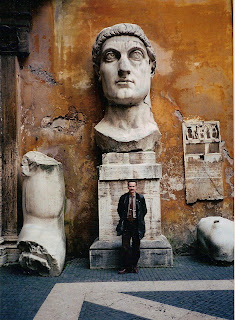

(Can this really be more than half a century later?)
1960 was the year of the Kennedy–Nixon Election. I, of course, supported Richard Nixon. I was still too young to think for myself. I came from a strong Republican background. Bob Rich— my maternal grandfather, for whom I was named – after all, had been a Republican member of the House for almost two decades. Furthermore, "Experience Counts!" John Kennedy was nothing but a young whipper-snapper!
In typical fashion, I overplayed my enthusiasm. I wish I had a photograph of it!! For the Halloween parade at Steele Elementary School, I went as a Nixon supporter. No jest intended. I wore black pants with 'NIXON' in white adhesive tape up one leg, and 'LODGE' on the other, an 'N' on one shoe, an 'L' the other, campaign buttons on my sleeves, and a sandwich sign with Nixon-Lodge campaign posters. I carried two other double-sided mounted posters on wooden sticks and, of course, wore a Nixon boater hat with extra buttons on the band.
I was crushed when Nixon lost.
(How quickly …and soundly I changed!)
###
On April 18, 2007 I listened to NPR, and at the end of an obituary for Kitty Carlisle Hart, as she sang Smoke Gets in Your Eyes during the credits, I recalled the autumn of my sophomore year in New Haven
Anyway, on Saturday night 04/21/07 I went to a small, local Spizzwink(?) alumni get-together at Perry’s on Union Street
On leaving my flat, I had picked up my copy of the Spizzwink(?) song book from 1971. When I opened it I came across a notation on the back of a sheet of music: “Latest Harris Poll H 43 N 40” The night before the ’68 election, it had looked as though Humphrey would win! Devin, one of the newer alums and a graduate student in Poly Sci at UC Berkeley, was fascinated to hear that. He said that it showed you couldn’t depend on polling data then. Of course, 2000 demonstrated that even if Humphrey had received 43 % and Nixon 40 %, that alone would not necessarily have guaranteed election victory for either one.
(Check out my 10/02/08 posting : October Surprise 1980 (1968) for more comments on the ’68 election.)
####
In 1993 I met former President Nixon at a rehearsal for the Low Jinks during the summer encampment at the Grove. I introduced myself as Rob Bell, Robert F. Rich Bell, grandson of Congressman Robert F. Rich, who had served in the Congress with Nixon in the late forty’s and early fifty’s. Nixon said “I remember Bob Rich. He always asked: ‘Where are we going to get the money?’”* To his friends nearby Nixon exclaimed: “I knew this man’s grandfather!!” (This was Nixon’s first and last visit to the Grove after his resignation. For years he had been persona non grata in the Club, and not welcomed to the summer encampment.)
I was impressed – that he would remember after all these years. A few months later I learned from my nephew Sheridan, that Nixon had been at the embassy in Beijing about six months before, and when asked by my nephew –visiting his Dad at the embassy—if he remembered Congressmen Rich, Nixon admitted that he did not. So either Nixon’s memory was jogged by my nephew’s question, or he went back and researched his files. (The internet wouldn’t have been so friendly in 1993. There was no Google.) Either way, it’s still impressive.
###
* One thing about my grandfather: he may have been very stingy with the people’s money, but he was extraordinarily generous with his own.













